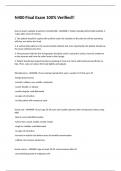N400 Final Exam 100% Verified!!
How to teach a patient to perform monthly BSE - ANSWER-1. Patient should perform BSE monthly, 5-
7 days after onset of menses.
2. The patient should lie supine with a pillow under the shoulder of the side she will be examining
with her arm above her head.
3. A vertical strip pattern is the recommended method, but more importantly, the patient should use
the same method every time.
4. Firm pressure with the first 3 fingerpads should be used in concentric circles, from the underarm
to the sternum and from the collar bone to the ribcage.
5. Patient should also inspect breasts by standing in front of a mirror with hands pressed firmly on
hips. Then, raise arm above the head slightly and palpate.
fibroadenoma - ANSWER--Occurs during reproductive years, usually 15-25 but up to 55
-benign breast tumor
-smooth, rubbery, very mobile, nontender
-round, disclike, or lobular
-usually singular, well delineated
-no signs of retraction
-no fluctuation with menstrual cycle
breast cyst - ANSWER--Occurs age 35-50 years and usually regresses after menopause (unless using
HRT)
-fluid or semi-solid filled nodule
-soft to firm, round, mobile, tender, elastic
-single or multiple, well delineated
-no signs of retraction
-increase in nodular size before onset of monthly menstruation
-caffeine can increase tenderness
breast cancer - ANSWER--Age of onset 30-90, most common after 50
-uncontrolled growth of malignant cells
,-irregular or stellate, firm or hard, nontender
-may be fixed to skin or underlying tissue
-not clearly delineated
-may have signs of retraction
-usually single but may coexist with other nodules
-often occurs in the tail of spence (upper outer quadrant of the axilla)
peau d'Orange - ANSWER-thickened skin with enlarged pores due to edema, usually seen on the
lower portion of the breast or areola and is associated with malignancy
supranumerary nipple - ANSWER-extra nipple located along the milk line; often mistaken for a
common mole. May have underlying glandular tissue. Is not pathologically significant
Structures located in RUQ abdomen - ANSWER--liver
-gallbladder
-duodenum
-aorta
-xiphoid
-head of pancreas
-lower pole of R kidney
-part of the ascending colon
- part of the transverse colon
Psoas sign - ANSWER-increasing abdominal pain when either raising the thigh against your hand or
extending the right leg at the hip while lying on the left side is positive for appendicitis
Obturator sign - ANSWER-Right hypogastric pain while flexing the right thigh at the hip and rotating
the leg internally at the hip is a positive sign for appendicitis
Murphy's sign - ANSWER-Sharp increase in abdominal pain when patient takes a deep breath with
fingers hooked at area of the liver/gallbladder is a positive sign of cholecystitis
, Gray-Turner's sign - ANSWER-bruising of the flank that may indicate a peritoneal bleed or
hemorrhagic pancreatitis
Appendicitis - ANSWER-mild cramping pain at the umbilicus that usually lasts 4-6 hours then shifts to
the RLQ and becomes more steady and severe. Patient may also have pain in the right flank at
McBurney's point. Associated symptoms often include anorexia, nausea, vomiting, guarding,
abdominal rigidity, rebound tenderness, and low grade fever. Rectal and pelvic exams should be
performed to assist in diagnosis.
Acute cholecystitis - ANSWER-Gradual, steady, aching RUQ pain that may radiate to the scapula.
Associated symptoms include anorexia, nausea, vomiting, and fever.
Acute pancreatitis - ANSWER-Steady epigastric pain that may be poorly localized or may radiate to
other parts of the abdomen. Associated symptoms include nausea, vomiting, abdominal distention,
and fever. Often occurs in patients that have a history of alcohol abuse or previous gallstones. Lying
supine worsens the pain while leaning forward alleviates it.
Chronic pancreatitis - ANSWER-Steady, deep epigastric pain that radiates through the back. Diabetes
is a potential cause. Associated symptoms include steatorrhea and enzyme insufficiency. Alcohol or
fatty meals exacerbates the pain while leaning forward may alleviate it.
Aortic aneurysm - ANSWER-characterized by a periumbilical or upper abdominal mass with wide,
bounding pulsations. Greater than or equal to 3cm and may have an audible bruit. Usually
asymptomatic unless dissecting, then patient may c/o severe ripping/tearing anterior chest pain that
radiates to the back, neck, or abdomen
Colorectal cancer - ANSWER-often causes a progressive narrowing of the bowel lumen that can cause
changes in bowel habits, crampy abdominal pain, bleeding, or acute blood in the stool. In rectal
cancer, patient often has pencil shaped stools (tenesmus) and weight loss.
Structures located in LUQ abdomen - ANSWER--spleen
-stomach
-body of pancreas
- L lobe of liver
-L adrenal
- upper pole of L kidney
-part of transverse colon




